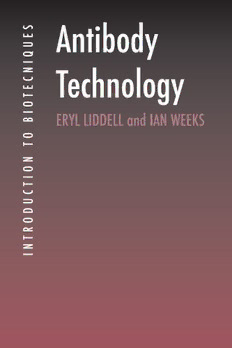
Antibody Technology PDF
Preview Antibody Technology
ANTIBODY TECHNOLOGY The INTRODUCTION TO BIOTECHNIQUES series Editors: J.M. Graham Merseyside Innovation Centre, 131 Mount Pleasant, Liverpool L3 5TF D. Billington School of Biomolecular Sciences, Liverpool John Moores University, Byrom Street, Liverpool L3 3AF Series adviser: P.M. Gilmarlin Centre for Plant Biochemistry and Biotechnology, University of Leeds, Leeds LS2 9JT CENTRIFUGATION RADIOISOTOPES LIGHT MICROSCOPY ANIMAL CELL CULTURE GEL ELECTROPHORESIS: PROTEINS PCR MICROBIAL CULTURE ANTIBODY TECHNOLOGY Forthcoming titles GENE TECHNOLOGY LIPID ANALYSIS GEL ELECTROPHORESIS: NUCLEIC ACIDS PLANT CELL CULTURE LIGHT SPECTROSCOPY MEMBRANE ANALYSIS ANTIBODY TECHNOLOGY Eryl Liddell School of Molecular and Medical Biosciences, Museum Avenue, PO Box 911, Cardiff CFl 3US, UK lan Weeks Department of Medical Biochemistry, University of Wales College of Medicine, Heath Park, Cardiff CF4 4XN, UK {1IOS SCIENTIFIC PUBLISHERS © BIOS Scientific Publishers Limited, 1995 First published 1995 Transferred to Digital Printing 2005 All rights All rights reserved. No part of this book may be reproduced or transmitted, in any form or by any means, without permission. A CIP catalogue record for this book is available from the British Library. ISBN 1 872748 87 2 BIOS Scientific Publishers Ltd 9 Newtec Place, Magdalen Road, Oxford OX4 IRE, UK Tel. +44 (0) 1865 726286. Fax +44 (0) 1865 246823 DISTRIBUTORS Australia and New Zealand India DA Information Services Viva Books Private Limited 648 Whitehorse Road, Mitcham 4325/3 Ansari Road Victoria 3132 Daryaganj New Delhi 110002 Singapore and South East Asia USA and Canada Toppan Company (S) PTE Ltd Books International Inc. 38 Liu Fang Road, Jurong PO Box 605, Herndon, VA 22070 Singapore 2262 Typeset by Chandos Electronic Publishing, Stanton Harcourt, UK. Contents Abbreviations ix Preface xi PART 1: BASIC PRINCIPLES AND METHODS 1. The Immune System 1 Introduction 1 Antibodies 2 Antibody biosynthesis 4 2. Production of Polyclonal Antibodies 9 Manipulation of the immune response 9 Antibody production 10 Mode of immunization 10 Dose of immunogen 11 Timing of immunizations 11 Characterization of antibodies 12 Titer 12 Affinity 15 Cross-reactivity 18 Immunoglobulin class 19 Chemical manipulations 20 Hapten-carrier protein conjugates 20 Solid-phase reagents 21 Labeled reagents 23 References 23 3. Production of Monoclonal Antibodies 25 Introduction 25 Basic methodology 26 Immunization 26 Tissue culture 28 Myelomas 28 Fusion 30 HAT selection 31 Antibody screening tests 32 v vi ANTIBODY TECHNOLOGY Cloning 33 Storage (cryopreservation) 35 Propagation of clones 35 Human hybridomas 38 Variations on basic methodology of production 38 Alternative lymphocytes 38 In vitro immunization 39 Heteromyelomas and hybrid hybridomas 40 Electrofusion 41 Alternative cloning methods 41 Characterization of antibodies 42 Making or buying: relative merits 42 References 44 4. Antibody Production by Chemical and Genetic Engineering 45 Introduction 45 Chemical modification 46 Antibody fragmentation: Fab and F(ab')2 46 Bispecific antibodies 48 Altering effector functions 49 Genetic manipulation 50 Humanizing rodent antibodies 50 Combinatorial antibody gene libraries 52 Summary and future prospects 62 References 63 PART 2: TECHNIQUES AND APPLICATIONS 5. Diagnostic Applications of Antibodies 65 Immunoprecipitation reactions 65 Radioimmunoassay 68 Radioactive labeling 69 Separation systems 71 Immunoradiometric assays 72 Other immunoassay architectures 74 Nonisotopic immunoassays 75 Enzyme immunoassay 76 Fluorescence immunoassay 78 Chemiluminescence immunoassay 79 Homogeneous immunoassays 81 Summary 82 References 83 CONTENTS vii 6. Immunolocalization 85 Introduction 85 Immunocytochemistry 85 Tissue and cell preparation 86 Choice of antibody 88 Choice of antibody label 89 Labeling strategies 94 Double and triple labeling 96 Nonspecific staining 99 Immunoblotting 100 References 102 7. Therapeutic Applications of Antibodies 103 Introduction 103 Antibody type and specificity 104 Polyclonal antisera 104 Rodent monoclonal antibodies 105 Humanized and CDR-grafted antibodies 110 Recombinant antibodies 111 Effector functions 111 Unlabeled antibodies 111 Labeled antibodies 112 Regulatory issues 117 Future prospects 118 References 118 8. Other Applications of Antibodies 121 Immunopurification 121 Biosensors 124 Catalytic antibodies 126 Epitope mapping 127 Fluorescence-activated cell sorting (FACS) 129 References 129 Appendices Appendix A: Glossary 131 Appendix B: Suppliers 135 Appendix C: Further reading 140 Index 143 Abbreviations 8-AG 8-azaguanine ADCC antibody-dependent cell-mediated cytotoxicity ADEPT antibody-directed enzyme prodrug therapy AP alkaline phosphatase APAAP alkaline phosphatase-anti-alkaline phosphatase C constant CDR complementarity determining regions CEA carcinoembryonic antigen CG chorionic gonadotropin CHO Chinese hamster ovary DAB 3.3'-diaminobenzidine dAb single-domain antibody EBV Epstein-Barr virus EF-2 elongation factor 2 ELISA enzyme-linked immunosorbent assay EMIT enzyme-multiplied immunoassay technique FACS fluorescence-activated cell sorter FCA Freund's complete adjuvant FIA Freund's incomplete adjuvant FITC fluorescein isothiocyanate FSH follicle-stimulating hormone GVDH graft-versus-host disease HAMA human anti-mouse antibody HAT hypoxanthine-aminopterin-thymidine HGPRT hypoxanthine guanine phosphoribosyl transferase HIV human immunodeficiency virus HRP horseradish peroxidase id idiotypic Ig immunoglobulin IL interleukin IRMA immunoradiometric assay IVIG intravenous immunoglobulin J joining LH luteinizing hormone MHC major histocompatibility complex MPO microperoxidase NK natural killer PAP peroxidase-antiperoxidase PCR polymerase chain reaction PEG polyethylene glycol RIA radioimmunoassay ix
